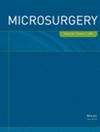Positive effect of ulnar nerve fascicle transfer to musculocutaneous nerve seeded with allogeneic adipose tissue derived stem cells on nerve regeneration for repairing upper brachial plexus injury in a rat model: A preliminary study
Abstract
Background
Traumatic peripheral nerve injury, with an annual incidence reported to be approximately 13–23 per 100,000 people, is a serious clinical condition that can often lead to significant functional impairment and permanent disability. Although nerve transfer has become increasingly popular in the treatment of brachial plexus injuries, satisfactory results cannot be obtained even with total nerve root transfer, especially after serious injuries. To overcome this problem, we hypothesize that the application of stem cells in conjunction with nerve transfer procedures may be a viable alternative to more aggressive treatments that do not result in adequate improvement. Similarly, some preliminary studies have shown that adipose stem cells combined with acellular nerve allograft provide promising results in the repair of brachial plexus injury. The purpose of this study was to assess the efficacy of combining adipose-derived stem cells with nerve transfer procedure in a rat brachial plexus injury model.
Methods
Twenty female Wistar rats weighing 300–350 g and aged 8–10 weeks were randomly divided into two groups: a nerve transfer group (NT group) and a nerve transfer combined adipose stem cell group (NT and ASC group). The upper brachial plexus injury model was established by gently avulsing the C5–C6 roots from the spinal cord with microforceps. A nerve transfer from the ulnar nerve to the musculocutaneous nerve (Oberlin procedure) was performed with or without seeded allogeneic adipose tissue-derived stem cells. Adipose tissue-derived stem cells at a rate of 2 × 106 cells were injected locally to the surface of the nerve transfer area with a 23-gauge needle. Immunohistochemistry (S100 and PGP 9.5 antibodies) and electrophysiological data were used to evaluate the effect of nerve repair 12 weeks after surgery.
Results
The mean latency was significantly longer in the NT group (2.0 ± 0.0 ms, 95% CI: 1.96–2.06) than in the NT and ASC group (1.7 ± 0.0 ms, 95% CI: 1.7–1.7) (p < .001). The mean peak value was higher in the NT group (1.7 ± 0.0 mV, 95% CI: 1.7–1.7) than in the NT and ASC group (1.7 ± 0.3 mV, 95% CI: 1.6–1.9) with no significant difference (p = .61). Although S100 and PGP 9.5 positive areas were observed in higher amounts in the NT and ASC group compared to the NT group, the differences were not statistically significant (p = .26 and .08, respectively).
Conclusions
This study conducted on rats provides preliminary evidence that adipose-derived stem cells may have a positive effect on nerve transfer for the treatment of brachial plexus injury. Further studies with larger sample sizes and longer follow-up periods are needed to confirm these findings.

 求助内容:
求助内容: 应助结果提醒方式:
应助结果提醒方式:


